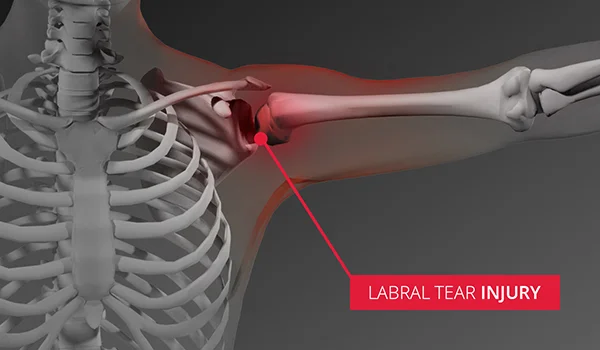
SYMPTOMS OF LABRAL TEARS OR SLAP TEARS
- Pain often described as feeling like it originates at the back of the shoulder.
- Pain in the front of the shoulder while performing biceps resistance exercises.
- Sensation of “catching or locking” or impeded range of motion.
- Instability symptoms such as feeling like the shoulder “slides out of place.”
POTENTIAL CAUSES
- Chronic Injury – Athletes participating in throwing sports like baseball or football, or repetitive overhead sports swimming and weightlifting are at risk of developing a SLAP tear over time from degeneration and overuse.
- Acute Injury – Acute or sudden trauma can also cause this injury. Falling on an outstretched arm is a typical example. Others include pulling on the arm powerfully or quickly moving the arm when it is over shoulder level.
- Aging – Tearing or fraying labrum can develop as part of general aging.
DIAGNOSIS
SLAP TEAR TREATMENT OPTIONS
Many SLAP tears may be treated non-operatively with relative rest and physical therapy. Icing the shoulder and anti-inflammatory medications can help with pain. Many minor tears will respond to conservative treatment. However, it is frequent for larger tears brought on by significant trauma to require arthroscopic surgery to heal. In patients who experience continued symptoms despite conservative treatment, arthroscopic surgery may be recommended. The indications for surgery should be based on an individual basis considering the patient’s age, activity level, functional needs, response to treatment, and time in season for athletes.
Several procedures may be performed and it is important to understand that SLAP tears are often seen in conjunction with other shoulder pathology such as instability or rotator cuff tears. When multiple injuries are diagnosed; these other conditions may influence how the SLAP lesion is addressed.
Surgery consists of arthroscopic repair of the labrum if it is an unstable tear or debridement (shaving) if it is a stable tear. Arthroscopy uses small incisions and allows the surgeon to view the shoulder joint on a TV monitor to use small instruments to perform the surgery. This is considered a minimally invasive procedure.
Debridement – For minor tears that do not involve the biceps tendon, torn or frayed portions of the labrum are trimmed away in order to leave a smooth edge, which is less likely to cause catching or irritation in the joint.
Repair – Repair involves creating bleeding of the bone on the edge of the socket. This involves the use of bio-absorbable suture anchors to which sutures are attached being imbedded in the edge of the socket (glenoid.) These sutures are placed through the labrum with specially designed tools and the sutures are then snugly tied, securing the torn labrum back to the glenoid rim.
Do you have shoulder pain that may be the result of a SLAP tear? Request an Appointment for a consultation with Sterling Medical Group.
